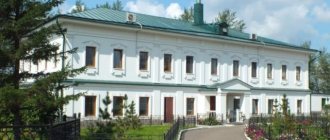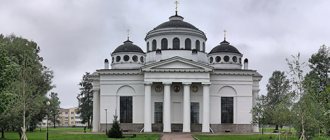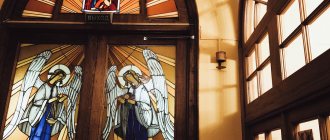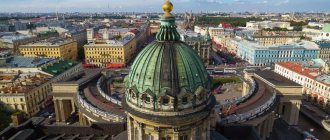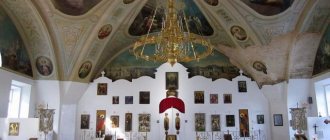This term has other meanings, see Znamensky Monastery.
| Monastery | |
| Znamensky Monastery | |
| Cathedral of the Znamensky Monastery, 2018 | |
| 55°45′08″ n. w. 37°37′43″ E. d.HGЯOL | |
| A country |
|
| Location | Moscow |
| Confession | Orthodoxy |
| Diocese | Moscow |
| Type | male |
| Date of foundation | 1631 |
| Building | |
| Znamensky Cathedral • Cell building with a bell tower • Fraternal building • Romanov Chambers • Service building | |
| Status | Object of cultural heritage of the peoples of the Russian Federation of federal significance. Reg. No. 771420278700006 (EGROKN). Object No. 7710097000 (WikiGida DB) |
| State | satisfactory |
| Media files on Wikimedia Commons | |
Znamensky Monastery in the Old Sovereign's Courtyard
- a former monastery in Moscow. Founded in 1629-1631. Consecrated in the name of the icon of the Mother of God “The Sign”. After 1923 the monastery was closed. The monastery cathedral has survived to this day. The monastery buildings are located at the address: Varvarka Street, 8-10.
History[ | ]
The area on Varvarka Street, where the monastery is located, belonged to the Romanov boyars in the 16th century[1]. There was a boyar courtyard and a house church, consecrated in the name of the Icon of the Mother of God “The Sign”. Upon the accession of Mikhail Fedorovich, the chambers on Varvarka began to be called the Old Sovereign's Court
[2]. It is believed that previously the courtyard could have belonged to the Khovrins of Surozhan and passed to N.R. Zakharyin-Yuryev after his marriage to a representative of the Khovrin family. The courtyard included three stone buildings and the house Church of the Sign[3].
There are two versions of the founding of the monastery. According to one of them, the monastery was founded in 1631 in memory of the death of the nun Martha, the mother of Tsar Mikhail Fedorovich. According to another, the monastery was founded in 1629 in honor of the birth of the heir to the throne. The ancestral icon of the Romanovs was brought to the monastery - the icon of the Sign of the Most Holy Theotokos[2]. In 1631, Patriarch Filaret issued a decree on the transfer of the antiquities of the old Znamenskaya Church to the first abbot of the monastery, Gerasim, and in November 1631, by royal decree, the estates of the nun Martha became the property of the monastery. Somewhat later, a stone church of St. St. Petersburg was built in the monastery. Athanasius of Athos.[4]
The monastery was badly damaged in a fire in 1668, but was soon restored. In 1679, the Church of St. St. Petersburg was dismantled. Athanasius of Athos and in its place they decided to build a stone five-domed cathedral. In 1679-1684, at the expense of boyar I.M. Miloslavsky (whose estate was located next to the monastery), masters Fyodor Grigoriev and Grigory Anisimov built a two-tier, five-domed Znamensky Cathedral. The upper cold temple was consecrated in honor of the “Sign” icon. The lower warm church was originally consecrated in the name of Athanasius of Athonite (later reconsecrated in the name of Sergius of Radonezh, and its chapel in honor of St. Nicholas the Wonderworker). The burnt chambers were rebuilt; monastery shrines and documents were kept there[2]. In connection with the emergence of the new cathedral, the old Znamenskaya Church was reconsecrated in the name of the Annunciation of the Blessed Virgin Mary. Several especially revered relics were kept in the Znamensky Cathedral: an eight-pointed gilded silver cross (a gift from nun Martha Ivanovna in 1622); an ancient icon of the Sign of the Blessed Virgin Mary (a gift from Patriarch Philaret according to the inventory of 1631), an image of the Sign, embroidered in silk and gold with pearls with the inscription “Summer 7138” and others.[4]
Znamensky Monastery, 1882 Znamensky Cathedral, 2008 Znamensky Cathedral after restoration, 2018
In the 18th century, the monastery began to decline. The monastery buildings were noticeably damaged in the Trinity Fire of 1737. After the secularization of 1764, his lands were transferred to the treasury, and he himself was classified as third class[5]. At the end of the 18th century, a new flourishing of the monastery began. In 1780, the Annunciation Church and the old bell tower were dismantled. The cathedral was painted, its walls were decorated with stucco. A new bell tower was built (on the site of the Church of St. Apostle James), which became the main entrance to the cathedral[2][4].
During the Patriotic War of 1812, Napoleonic soldiers plundered the monastery. However, the cathedral itself was not damaged. During the occupation, it was even allowed to hold services in the lower church. After the war in 1813, the lower cathedral church was reconsecrated in honor of St. Sergius of Radonezh; Restoration work began, which was carried out by the architect Dmitry Borisov, and a new bell tower was built according to his design. By 1823, a new three-tiered gilded wooden iconostasis was made at the expense of Moscow merchants. In 1827 the monastery was reopened[2][4].
In 1856, during a visit to Moscow, Tsar Alexander II drew attention to the deplorable state of the chambers of his ancestors. The Emperor ordered the chambers to be restored to their original form and the “House of the Romanov Boyars” museum to be built in them. The work on the restoration of the monument and the organization of the museum was carried out by the director of the Armory Chamber A.F. Veltman, the architect F.F. Richter, the historians I.M. Snegirev, A.A. Martynov and the heraldist B.V. Köhne. In August 1859, the grand opening of the museum took place[2][5]. By royal decree, the northeastern part of the monastery territory with all the buildings (included in the newly formed museum) came under the jurisdiction of the Ministry of the Imperial Court[4].
In 1900, during a three-week stay in Moscow, the royal family visited Varvarka and visited the Romanov chambers and the monastery. In 1907, an archimandrite, nine monks and 12 novices lived in the Znamensky Monastery[5]. In 1910, a chapel was built in the upper church in the name of St. Mikhail Malein (not preserved). For the 300th anniversary of the Romanov dynasty, the cathedral was restored. In connection with this anniversary, Emperor Nicholas II and his retinue visited the Znamensky Monastery in 1913, where they were solemnly greeted by Archimandrite Modest with a cross and an ancient icon of the Mother of God of the Sign. Having venerated the cross and the icon, the emperor entered the cathedral, where a prayer service was served; After this, the emperor visited the chambers of the Romanov boyars.[4]
After the change of power in 1917, the monastery was closed in 1923. Its buildings and cathedral were converted into housing and warehouses. In 1930, the cathedral was partially destroyed - 4 small chapters were dismantled, the cross with an onion was removed from the central chapter, and the entrance staircase was broken.[4]
By the early 1960s, the farmstead building and stables were demolished, and the remaining buildings were in disrepair. But in connection with the construction of the Rossiya Hotel in Zaryadye in 1963-1972, work was carried out to restore the cathedral[5], which was then transferred to the House of Propaganda of the All-Russian Society for the Protection of Historical and Cultural Monuments. There were lecture halls and concert halls there. Another restoration was carried out in 1979-1980.[2][6]
After the collapse of the USSR, services were resumed in the Znamensky Cathedral in 1992[2]. The cathedral and chambers are part of the Romanov Chambers Museum, a branch of the State Historical Museum. The board of the All-Russian Society for the Protection of Historical and Cultural Monuments is located in the abbot's cells[7]. In 2015, the Moscow government announced a competition for the restoration of the cathedral.[8] By 2017, the Znamensky Cathedral was restored, becoming red and white. The bell tower and the Fraternal Building were also restored.[9][10]
Today, the buildings of the Znamensky Monastery are part of the Zaryadye Park complex.[6]
Znamensky Monastery (Moscow)
The area on Varvarka Street, where the monastery is located, belonged to the Romanov boyars in the 16th century. There was a boyar courtyard and a house church, consecrated in the name of the Icon of the Mother of God “The Sign”. After the accession of Tsar Mikhail Fedorovich to the throne, the chambers on Varvarka began to be called the Old Sovereign's Court
[1]. It is believed that previously the courtyard could have belonged to the Khovrins of Surozhan and passed to Nikita Zakharyin-Yuryev (the grandfather of Tsar Mikhail Romanov) after his marriage to a representative of the Khovrin family. The courtyard included three stone buildings and the house Church of the Sign[2].
There are two versions of the founding of the monastery. According to one of them, the monastery was founded in 1631 in memory of the death of the nun Martha, the mother of Tsar Mikhail Fedorovich. According to another version, the monastery was founded in 1629 in honor of the birth of the heir to the throne. A family icon of the Romanovs was brought to the monastery[1].
The monastery was badly damaged in a fire in 1668, but was soon restored. In 1679-1684, a new cathedral was built at the expense of boyar Ivan Miloslavsky. The architects of the cathedral are Fyodor Grigoriev and Grigory Anisimov. The five-domed temple was built in Russian traditions and had two tiers. The upper cold temple was consecrated in honor of the “Sign” icon. The lower warm temple was initially consecrated in the name of Athanasius of Athos (later the lower temple was re-consecrated in the name of Sergius of Radonezh, and its chapel in honor of St. Nicholas the Wonderworker). The burnt chambers were rebuilt. Documents and relics of the monastery were kept there[1].
In the 18th century, the monastery gradually began to decline. After the secularization of 1764, the lands of the monastery were transferred to the treasury, and the monastery itself was classified as 3rd class[3]. At the end of the 18th century, a new flourishing of the monastery began. The cathedral was painted, its walls were decorated with stucco. A new bell tower was built, which became the main entrance to the cathedral[1].
Znamensky Cathedral
During the Patriotic War of 1812, Napoleonic soldiers plundered the monastery. However, the cathedral building was not damaged then. During the occupation, it was even allowed to hold services in the lower church. After the war, restoration work began, which was carried out by the architect Dmitry Borisov, and a new bell tower was built according to his design; in 1827 the monastery was reopened[1].
In 1856, during a visit to Moscow, Alexander II drew attention to the deplorable state of the ancestral chambers of the Romanov boyars. The Emperor ordered the chambers to be restored to their original form and the “House of the Romanov Boyars” museum to be built in them. The work on the restoration of the monument and the organization of the museum was carried out by the director of the Armory Chamber Alexander Veltman, architect Fyodor Richter, historians Ivan Snegirev, Alexey Martynov and heraldist Bernhard Köhne. In August 1859, the grand opening of the museum took place[1][3].
In 1907, an archimandrite, nine monks, and 12 novices lived in the Znamensky Monastery[3]. For the 300th anniversary of the Romanov dynasty, the cathedral was restored. In 1910, a chapel was built in the upper church in the name of St. Mikhail Malein.
After 1923 the monastery was closed. Its buildings and cathedral were adapted for housing. By the early 1960s, the farmstead building and stables were demolished, and the remaining buildings were in disrepair. But in connection with the construction of the Rossiya Hotel in Zaryadye in 1963-1972, work was carried out to restore the cathedral[3]. Then the cathedral building was transferred to the House of Propaganda of the All-Russian Society for the Protection of Historical and Cultural Monuments. There were lecture halls and concert halls[1]. Another restoration was carried out in the 1980s.
Since 1992, divine services have been resumed in the Znamensky Cathedral[1]. The cathedral and chambers are part of the Romanov Chambers Museum, a branch of the State Historical Museum. The board of the All-Russian Society for the Protection of Historical and Cultural Monuments is located in the abbot's cells[4].
Abbots[ | ]
| This section is not completed. You will help the project by correcting and expanding it. |
- Joseph (June 1702-1708)
- Alexy (Titov) (1708 - ?)
- Cyprian (Skripitsyn) (January 10, 1732-1733)
- Sofroniy Mladenovic (October 17, 1770—1776)[11]
- Serapion (Alexandrovsky) (January 27, 1776 - February 16, 1779)
- Innokenty (Polyansky) (August 1782 - 1783)
- Iriney (Klementyevsky) (December 9, 1783 - 1784)
- Moses (Gumilevsky) (from November 21, 1784)
- Irakli (Evreinov) (1788—1797)
- Gennady (Shumov) (1808-1810)
- Innokenty (Smirnov) (October 14, 1810 - 1812)
- Neophyte (Dokuchaev-Platonov) (August 12, 1814 - September 25, 1816)
- Apollos (Alekseevsky) (December 18, 1816 - December 20, 1817)
- Aristarchus (1817 - 1821)
- Gabriel (September 12, 1821 - 1825)
- Gabriel (March 4, 1825 - March 18, 1830)[12]
- Evlampy (Pyatnitsky) (March 28, 1830-1831)
- Platon (Kazansky) (December 21, 1831 - 1833)
- Ioannikiy (Kholuysky) (December 3, 1845 - 1850)
- Leonid (Krasnopevkov) (1850—1854)
- Innokenty (Orlov) (1854—1859[13])
- Ignatius (Rozhdestvensky) (August 7, 1859—1863)
- Sergius (Spassky) (October 25, 1863 - August 12, 1866)
- Kirill (Orlov) (April 23, 1872 - 1880)
- Macarius (Troitsky) (February 25, 1881-1882)
- Archimandrite Niim (1883—?)
- Vladimir (Philanthropov) (1892-1895)
- Serapion (Mashkin) (1897-1900)
- Tobia (Tsymbal) (early 1903 - March 6, 1904)
- Afanasy (Sambikin) (April 22, 1904 - February 1908)
- Modest (Nikitin) (February 16, 1908 - May 19, 1914)
- Aristarkh (Nikolaevsky) (May 19, 1914 - March 8, 1920)
- Mitrofan (Grinev) (August 20 - November 1, 1920)
- Victor (Bogoyavlensky) (December 1920 - 1921)
Notes[ | ]
- Rudakov V. E.
Znamensky Monastery, in Moscow // Encyclopedic Dictionary of Brockhaus and Efron: in 86 volumes (82 volumes and 4 additional). - St. Petersburg, 1890-1907. - ↑ 1 2 3 4 5 6 7 8 Lebedeva E.
Moscow Znamensky Monastery
(unspecified)
. Pravoslavie.Ru (December 10, 2008). Access date: August 27, 2011. - Architectural Monuments, 1983, p. 449.
- ↑ 1234567
Znamensky Cathedral of the former Znamensky Monastery. - ↑ 1234
Znamensky Monastery // Encyclopedia “Moscow” / ed. S. O. Schmidt. - M.: BRE, 1997. - 976 p. - ↑ 12
Znamensky Monastery in Moscow. Part 2. - Zaryadye will get out of the “Chechulinsky chest” (undefined)
. - The Znamensky Cathedral in Moscow will be restored. 2015
- Through three centuries: in Zaryadye, restorers have recreated the lost interiors of monastic cells of the 17th century. 2021
- In the center of the capital, the restoration of the Znamensky Monastery has been completed. 2018
- Nikolsky A.I.
Sophrony (Mladenovich) // Russian biographical dictionary: in 25 volumes. - SPb.-M., 1896-1918. - Gabriel (archimandrite) // Russian biographical dictionary: in 25 volumes. - SPb.-M., 1896-1918.
- Innokenty (Orlov) // Russian biographical dictionary: in 25 volumes. - SPb.-M., 1896-1918.
In the center of the capital, the restoration of the Znamensky Monastery has been completed
The 17th-century building survived several historical eras and was repeatedly destroyed and restored. And now it looks exactly as the architects intended it more than 300 years ago. The engineers of our time only made some amendments: communications were connected to the building for the first time.
Znamensky Monastery, in the Old Sovereign's Courtyard - that's what this place on Varvarka used to be called. The monastery itself is long gone, but the building with the monastic cells and the cathedral have been preserved - the main church of the Patriarchal Metochion in Zaryadye. The historical buildings were under restoration for about a year and now look the same as they did three centuries ago.
“It was a complex restoration, it took place in two stages. Last year work was carried out on the facades. This year, restorers worked on the interiors. Moscow City Heritage experts monitored this work very carefully and, I must say, last week the restoration work was accepted,” said Alexey Emelyanov, head of the Moscow Department of Cultural Heritage.
The lost interiors of monastic cells were recreated in the Brotherhood Corps. Inside, a wooden floor has reappeared, pine doors and small windows through which light barely shines have been returned - everything is as ascetic as in the 17th century.
“These were abbot’s cells. At one time, Metropolitan Abraham lived here, and there were metropolitan chambers here. That is, at different times they were used in different ways,” says Archpriest Vyacheslav Shestakov, rector of the Church Compound in Zaryadye.
The foundation was strengthened and the brickwork was restored; for the first time, communications were laid to the Fraternal Corps - sewerage and water supply. Restorers restored the historical descent to the building in the western part, and, on the contrary, blocked the old entrance in the northern part.
“Based on the documents that were found by the design organization, we just restored and made a project for recreating the interiors of the Northern cell building. And we developed a preliminary design for Yuzhny, which was blown up,” continues Vyacheslav Shestakov.
The fraternal building of the Znamensky Monastery was built by Kostroma masters Fyodor Grigoriev and Georgy Anisimov. This is the oldest example of Russian architecture. The building is made in the traditional architectural style of the 17th century - Russian or Moscow patterned. These are tower vaults and platbands in the form of kokoshniks.
Over the centuries-old history, the monastery was destroyed several times. For example, in 1812 the cathedral was plundered by Napoleonic soldiers. But, despite everything, the Znamensky Monastery continued to live.
“It has a direct bearing on our three-hundred-year history. Once upon a time this was the Old Sovereign’s Court, that is, from here, in particular, the history of our last royal dynasty, the Romanovs, began,” says Moscow expert Yulia Demitrova.
Now the fraternal corps of the Znamensky Monastery will take part in the annual restoration competition. And work on the cathedral will continue.
Literature[ | ]
- Sergius (Spassky), archbishop.
Historical description of the Moscow Znamensky Monastery, which is in the old sovereign’s courtyard. - M., 1866. - Kazakevich I. I.
Moscow Zaryadye: History of architectural monuments / Photography by D. V. Belous and others; Artist A. A. Ryumin; Per. N. I. Shebeko. - M.: Art, 1977. - P. 90-148. — 208 p. - Libson V. Ya., Domshlak M. I., Arenkova Yu. I. and others.
The Kremlin. China town. Central squares // Architectural monuments of Moscow. - M.: Art, 1983. - P. 449-450. — 504 p. — 25,000 copies. - Romanyuk S.K.
Moscow. China Town: Guide. — M.: ANO IC “Moskvovedenie”; OJSC "Moscow Textbooks", 2007. - 320 p. — (New Moscow guide).
History of the Church of the Mother of God "Sign"
The Cathedral of the Icon of the Mother of God on Varvarka in Moscow was consecrated in the name of the “Sign” icon.
There are several assumptions about the origin of the temple and the monastery around it. It is known for sure that the complex originally belonged to the Romanov boyars.
Perhaps it was founded in 1631 after the death of Martha, the mother of Mikhail Fedorovich, perhaps in 1629 with the appearance of the Romanov heir.
In 1668, the Cathedral was badly damaged during a fire. Thanks to boyar Ivan Miloslavsky, the temple was rebuilt.
Until the end of the 18th century, the building of the Cathedral of Our Lady of the Sign and the monastery were in decline.
In 1812, the Cathedral was plundered, but was not damaged: services were even held here. After the Napoleonic War - restoration work again and a new opening in 1827.
When Alexander II arrived in Moscow in 1856, the condition of the shrine left much to be desired.
By order of the emperor, it was decided to give the Cathedral the appearance that it had during the reign of the Romanovs, and to open the “House of the Romanov Boyars” museum on the territory of the monastery.
